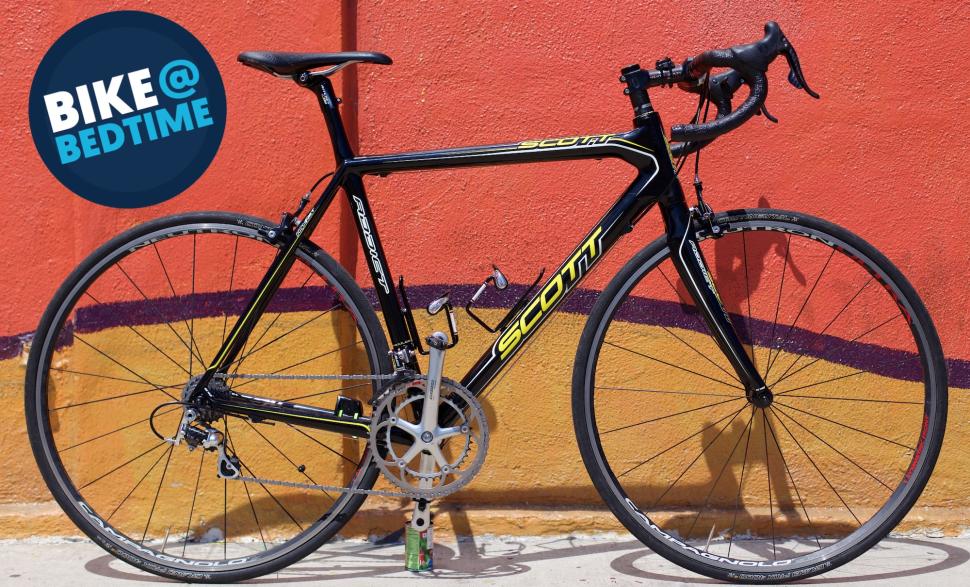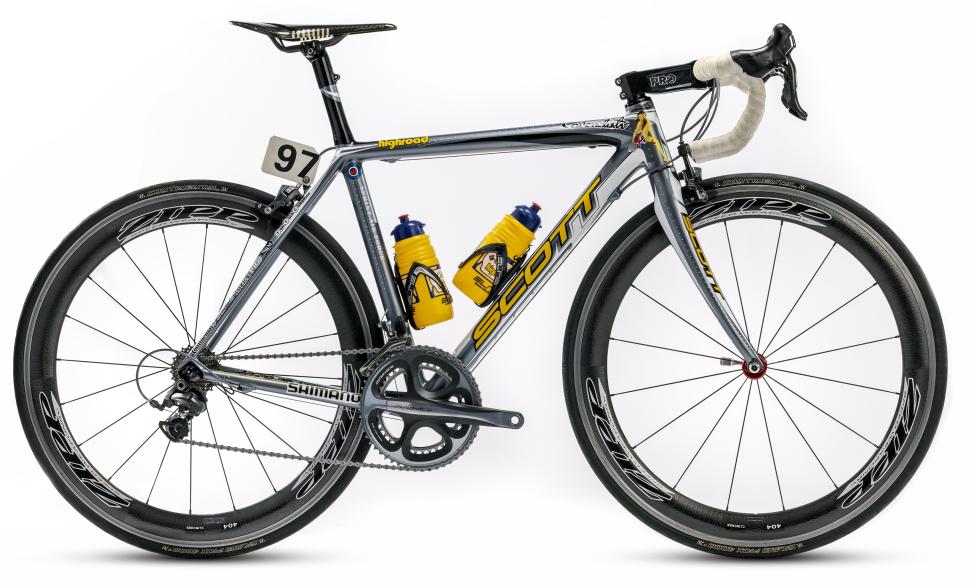- News
- Reviews
- Bikes
- Accessories
- Accessories - misc
- Computer mounts
- Bags
- Bar ends
- Bike bags & cases
- Bottle cages
- Bottles
- Cameras
- Car racks
- Child seats
- Computers
- Glasses
- GPS units
- Helmets
- Lights - front
- Lights - rear
- Lights - sets
- Locks
- Mirrors
- Mudguards
- Racks
- Pumps & CO2 inflators
- Puncture kits
- Reflectives
- Smart watches
- Stands and racks
- Trailers
- Clothing
- Components
- Bar tape & grips
- Bottom brackets
- Brake & gear cables
- Brake & STI levers
- Brake pads & spares
- Brakes
- Cassettes & freewheels
- Chains
- Chainsets & chainrings
- Derailleurs - front
- Derailleurs - rear
- Forks
- Gear levers & shifters
- Groupsets
- Handlebars & extensions
- Headsets
- Hubs
- Inner tubes
- Pedals
- Quick releases & skewers
- Saddles
- Seatposts
- Stems
- Wheels
- Tyres
- Health, fitness and nutrition
- Tools and workshop
- Miscellaneous
- Cross country mountain bikes
- Tubeless valves
- Buyers Guides
- Features
- Forum
- Recommends
- Podcast
feature
 2008 Scott Addict R2 daniel dvc on Flickr Creative Commons, CC BY 2.0- - 1
2008 Scott Addict R2 daniel dvc on Flickr Creative Commons, CC BY 2.0- - 1Check out Scott’s sub-6kg Addict from 2008
Scott has this week launched its new Addict RC road bike with full builds weighing as little as a claimed 5.9kg, and we’ve not seen weights that low from the brand since the first Addict was launched for the 2008 model year, so let the screen go all swirly for a moment as we journey back through time to see how things were when road.cc was a little baby website and the world banking system was having a bit of a moment.
Main image: daniel dvc on Flickr Creative Commons, CC BY 2.0 https://creativecommons.org/licenses/by/2.0/
> Scott unveils new 5.9kg Addict RC road bike... the same weight as the 2008 version
Scott actually announced that the first Addict was on the way in 2007, before road.cc even existed, and there was immediately a huge focus on its weight – or, more precisely, the lack of weight.

How did Scott end up with a frame that was so lightweight for the time? That Addict used what Scott called its Integrated Molding Process (IMP)… and no, that's not how we would spell moulding either. This, Scott reckoned, allowed its engineers to create multiple tubes in a single step while managing the thickness and characteristics of the layers in different areas.
Although carbon monocoque bike frames had existed for years, most early carbon-fibre frames were made from preformed tubes that were then joined – either tube-to tube or slotting into lugs. Some are still made this way, but the Addict was made with fewer joints. This meant that less material needed to be added, keeping the weight down.
The head tube, top tube and down tube were all created as a single piece. That might not sound particularly radical now but don’t forget that carbon fibre hadn’t taken over the bike industry back then to the degree it has today. Carbon components, including frames, were certainly part of the scene, particularly in high-level road racing, but the technology wasn’t as developed back then.
Scott was big on optimising carbon fibre so that less of it could be used, resulting in a lighter overall structure. For example, it spent a lot of time and effort working on tube shapes because those shapes helped manage the loads at the junctions. It also used carbon for just about everything, including the dropouts, cable stops, and even the front derailleur mount.
That first Addict was astonishingly fast, Scott managing to retain a high level of frame stiffness despite the low weight. The acceleration and climbing were as stunning as you'd imagine while descents were perfectly controlled too (although if you went for a model with carbon wheels, the rim brakes could sometimes be a little unpredictable).
Why has it taken so long for Scott to produce another sub-6kg Addict? Keep in mind that there has been limited incentive for brands to reduce the weight of road race bikes over the past couple of decades because they’re all perfectly capable of producing models as light as the UCI’s 6.8kg minimum weight limit for racing (introduced in 2000).
Even if there had been the motive to reduce weights, the use of disc brakes on the road came along and moved things in the opposite direction for a while. It has only really been since Specialized released its Aethos with a claimed frame weight of 588g back in 2020 that weight reduction has been back in the big time. That model has been raced at a professional level, but only when built up with components selected to take the overall bike weight above the minimum permitted.
> Here’s why the Specialized Aethos non-race bike is being raced in the Tour de France
 The Scott Addict was already a renowned bike, but if anyone had missed it before, it came to even more prominence in 2009 when it was ridden by Team Columbia–High Road (which became Team Columbia-HTC), including a certain Manx rider called Mark Cavendish. Even by his own standards, Cav had a fabulous year in 2009, winning Milan-San Remo and three stages of the Giro d’Italia (amongst other races) before going to the Tour de France and bagging a ridiculous six stage victories.
The Scott Addict was already a renowned bike, but if anyone had missed it before, it came to even more prominence in 2009 when it was ridden by Team Columbia–High Road (which became Team Columbia-HTC), including a certain Manx rider called Mark Cavendish. Even by his own standards, Cav had a fabulous year in 2009, winning Milan-San Remo and three stages of the Giro d’Italia (amongst other races) before going to the Tour de France and bagging a ridiculous six stage victories.
The Scott Addict has changed a lot over the years – with new carbon fibre, internal routing, and disc brakes, for instance – but that first version set the tone for everything it has become since. Right, let's get back to 2024.
Mat has been in cycling media since 1996, on titles including BikeRadar, Total Bike, Total Mountain Bike, What Mountain Bike and Mountain Biking UK, and he has been editor of 220 Triathlon and Cycling Plus. Mat has been road.cc technical editor for over a decade, testing bikes, fettling the latest kit, and trying out the most up-to-the-minute clothing. He has won his category in Ironman UK 70.3 and finished on the podium in both marathons he has run. Mat is a Cambridge graduate who did a post-grad in magazine journalism, and he is a winner of the Cycling Media Award for Specialist Online Writer. Now over 50, he's riding road and gravel bikes most days for fun and fitness rather than training for competitions.

I am absolutely certain that it's not fair for trans-identifying males who went through male puberty to compete in female sports... and that should...
I was just excited to learn that Grundig were still a going concern, let alone making stuff for bikes now! What's next, Blaupunkt power meters?!
White shoes:...
Nothing to do with cycling, and currently unclear as to what exactly happened. But a child is dead, a tram line isn't running services and ...
Sidelining the point here a little bit, but I was just looking at a Rapha video about Lachlan Morton's latest incredible venture of riding 648km in...
Or, you can just look at them - it's pretty obvious when they're not going to work with a new chain. Then you can try them with old lengthened...
I bought 5 screw in storage hooks from local d.i.y store for £10. Does the same job 🤷♂️
Well it looks like they've got a page now. It says they'll accept video evidence but I haven't been through the whole process. Looks very similar...
Sorry, but the BBC is definitely tilting towards cycling after the Panorama debacle....
Unlikely. Not once he hears that it'll 'help Gore'.